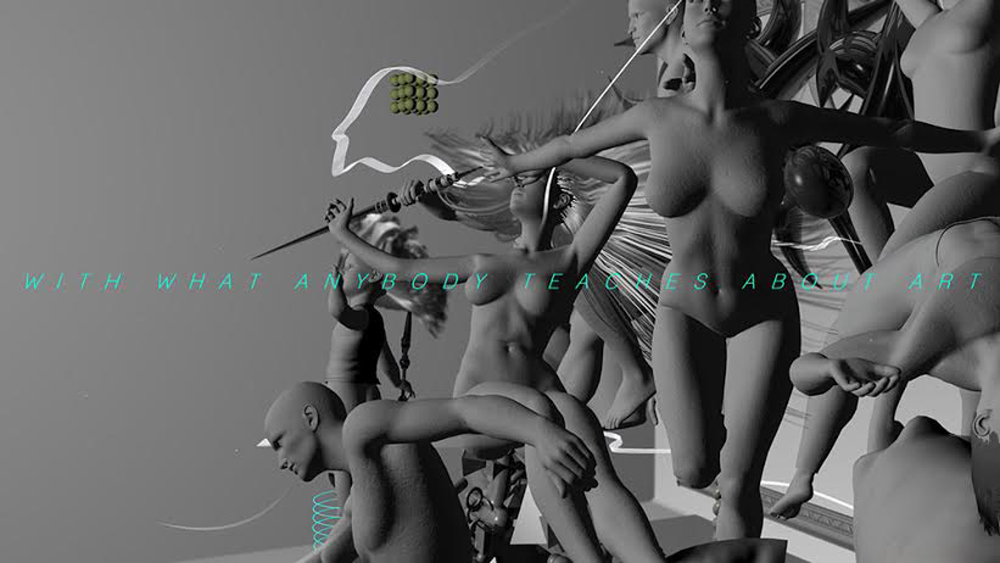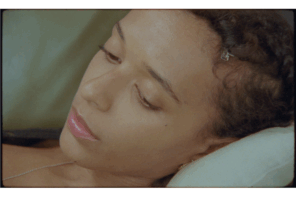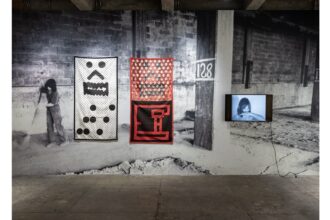Let me begin with an art historical chestnut — a 1855 painting by the French painter Gustave Courbet called The Artist’s Studio, A Real Allegory Summing Up Seven Years of My Artistic Life. In it, we see the artist putting the final touches on a pleasant landscape. A naked female muse approvingly looks over his shoulder and a young boy looks up in awed respect. There are two crowds flanking Courbet: on the right, there’s what we might call the artworld, with people like the critic Champfleury and Charles Baudelaire. On the left stand what we might call the masses, or per more contemporary parlance, the commons. There’s a priest, a merchant, a beggar, and a whole roll call of marginalized social types. In the “real allegory” of his painting, Courbet suggests that both the social avant-garde and the common man motivate his work culminating in a democratic harmony fueled by the artist’s unique gifts.
I thought about this painting, which admittedly now reads as an aggrandizement of the male lefty artist, as the summation of the fantasized artist’s studio, replete with admirers, friends, and a markedly inclusive public. In Courbet’s rendition, art-making mends social differences and joins together all sorts of people, from the intelligentsia to the subaltern. Imagined in line with Courbet’s own radical communitarian politics, the artist’s studio is a utopic scene of the collective.
I then thought about Courbet’s studio in relation to its arguable antipode, net art. What does the net artist’s studio look like? One imagines the entirety of Courbet’s auditorium compacted into a computer with the artist’s proponents, collaborators, and spectators accessed at one point. Net art is disseminated, viewed, collected, and consumed with immediate connectivity by a network of both artworld professionals and casual browsers. But if there’s a network of affiliation, is there a collective? What kind of structure of social belonging or community does this art speak to? When you network, you make contacts, not necessarily friends. The majority of net art is viewed online and alone. For an art-form predicated on circulation and distribution, net art more often than not surfaces as an atomistic field of individual users, producers, and consumers.
In the last year or so since I’ve been writing on net art, my primary critique of the form has been that net art clones the mostly deadening experience of being online, rather than challenging or expanding it. Looking at Tumblr, Pinterest, and the strangely historical collection of funny GIF lists that used to populate the internet is almost identical to taking in net art exhibitions online. In the genre’s splashier ventures, like the Wrong Biennial or the inaugural all-GIF film twohundredfiftysixcolors, parsing the collection of online material generated a fatigued sense of perception. If net art, as I’d speculate, takes its historical cue from the impossibly diverse archive of cable television, is there an online equivalent to David Hall’s 1971 “TV Interruptions”? Net art is so often experienced in solitary confinement, which makes moments of its actually public display all the more promising.
Brooklyn’s TRANSFER Gallery offered such an opportunity this summer with a screening of Ways of Something, a six-episode series of films curated by the Canadian net artist Lorna Mills. Ways of Something is comprised of various sixty-second clips bridged by a voice-over from John Berger’s 1972 BBC miniseries, Ways of Seeing, a widely-watched mini-series he eventually turned into a foundational essay for visual culture studies. In the original show, Berger invited his large broadcast audience to a pedagogical exposé on the politics and techniques of the art-historical canon and everyday imagery more broadly. He focused on, through the writing of Walter Benjamin, the status of art after its endless mechanical dissemination and the resulting technocratic relations of power.
Commissioned by Amsterdam’s Sandberg Instituut, Mills selected an international who’s-who of net artists to deconstruct Berger’s show. The first two episodes were screened this September; the first introduces the series’s aims and the second takes on historically conventional images of femininity and gender — you can watch the pilot here.
Sandberg’s Julia van Mourik runs “The One Minutes,” a platform for experimental films of the nominal sixty-second duration. Following Mourik’s orders, Mills stipulated that each artist select one minute from an assigned Berger episode, with the only proviso being that Berger’s narration stay in place and that subtitles be visible. With Mills only scantly editorializing her submissions, the film’s visual component was as heterogeneous as one might expect. The standard strategies of net art’s moving image appeared: video-game simulations, webcam vamping, geometric trickery, and fractured text sequences replaced each other with brisk pacing.
Most artists approached the venerable Ways of Seeing with cheeky derision, the type of casual mockery that undergirds most online chatter. Great Master paintings were twisted and deranged (Courbet would be under fire here); memes scored Berger’s serious analysis of ideology and vision; and a perpetually nodding skull wearing a Google Glass-like apparatus mindlessly affirmed its background narration. When artists like Rea McNamara, Jennifer Chan, Rhett Jones, Carrie Gates, and Erica Lapadat-Janzen engaged darker, more melancholic, or curiously emotional tones – such as Jones’s citation of war footage – these resonant minutes registered as blips. They were like snippets of errant programming when flipping channels.
Ways of Something was, in effect, consumable, which is not to say boring: it almost always entertained, and Berger’s exegeses in fact lost none of their potency more than forty years later. But the problem of a medium that takes its compositional cue from Tumblr becomes pronounced. In a work split thirty ways, chains of detail replace any kind of formal cohesion by definition. Reflecting on the film months after the fact, I can only process the unity of a single episode as the product of its myriad components. Each episode crystallizes as a series of impressions whose connection to one another feels arbitrary or circumstantial. When sheer difference is the guiding aesthetic for a work of art, the evaluation of that art condenses into vague critical reduction. How do we process a work of art fed by the rapid fragmentation of the online screen, especially when its unique aesthetically components are so explicitly composed as different sources? In short, how are we to understand any media that is pure aggregation?
In a well-known essay called “In Defense of the Poor Image,” Hito Steyerl describes her nominal subject as the base material of visual culture. The poor image is low-res, illegible, cheap, mobile, at times obscene — and arguably the building block of net art. Ways of Something itself staged the confrontation between the rich images of Berger’s art history and the poor images of its myriad interventions. In this sense, the poor image isn’t necessarily a bad thing, and for Steyerl it carries political potential in its distance from the instutionalism of more sumptuous or spectacular media. But this potential is wide open. As Steyerl notes, “Poor images are thus popular images — images that can be made and seen by many. They express all the contradictions of the contemporary crowd; its opportunism, its narcissism, desire for autonomy and creation, its inability to focus or make up its mind, its contact readiness for transgression and simultaneous submission. Altogether, poor images present a snapshot of the affective condition of the crowd, its neurosis, paranoia, and fear, as well as its craving for intensity, fun, and distraction.” Consider Ways of Something as an inventory of poor images and the wildly divergent aesthetics and responses they elicit. It stands as a representative for net art’s inveterate disregard for cohesion. A work of art that can’t make up its mind — that embraces distraction as a guiding sensibility — is a critic’s nightmare.
However, it would be bad criticism to lament net art’s fragmentation as so much newfangled, random chaos. Division, citation, and assemblage are standard technique across modernism, from structuralist film to Dadaist photomontage to Courbet’s Realism, which disjunctively pasted in tropes from popular media. You could even stretch back to Brueghel’s narratively chaotic canvases; his 1564 Procession to Calvary makes an appearance in Joe McKay’s minute in the pilot. Mills’s own work, particularly her GIF tableaux, shrewdly build on these examples, intentionally or otherwise; they seem to distill the internet writ large into curious combinations of images (often people or animals, often fucking) writhing, shaking, and trembling per the GIF’s weird para-mobility.
But what might separate net art from its antecedents is the expansion of fragmentation and division from an aesthetic strategy to an institutional framework. The production and reception of Ways of Something, from Sandberg’s outsourcing of its curation to Mill’s assemblage of her various components, repeat in the standard mode of watching the film— on a Vimeo page on your computer. If in 1972 Ways of Seeing found distribution in the mass public of broadcast television, then Ways of Something adapts that presentation for 2014 through the networked but inherently split mode of online viewing. This is why TRANSFER’s screening of Ways of Something, even if maybe just a gallery event, seemed to clarify the extensive implication of Mills’s project. What kind of community was formed in watching this patchwork collage of online material as a singular viewing experience? More broadly, what does it mean to watch the internet collectively?
As Ben Davis intoned in a recent review of Ways of Something, the film poses these exact questions of watching and consuming. I think Mills’s work offers a response by something of a caveat (and Davis in turn celebrates the film’s adaptation of Berger and Walter Benjamin without a productive reading of the film itself). Instead of proffering some real critique of internet spectatorship, Ways of Something relies on its wild stylistic heterogeneity to provide a non-answer. Steyerl touches on this when she ambivalently suggests the full range of political participation her idea of the poor image elicits. You can probably predict my next line: the medium is the message. Net art and related practices’ reliance on the fragment, component, or collage carries little weight in the boundless digital archive of poor images that constitutes our visual culture.
This is why I think net art, or really any art that takes the internet as its point of departure, makes its most interesting commentary precisely when it goes offline. What if Ways of Something was also broadcasted on TV as its own series? The argument could be made Ways of Something should be seen online for the very reason that for better or worse, our engagement with culture happens with a broadband connection now (and this runs the risk of political generalization — it’s too easy to take internet access for granted in conversations around new media). But to summon a different Walter Benjamin then the one Berger and Davis consider, by comparing net art to more obsolete technologies of circulation and collectivity, like television or the history painting, we then might grasp the changes in social belonging and affiliation currently underway. If Courbet performed what he thought was painting’s power for democratic inclusion in The Artist’s Studio, I’m curious to see what similar ideation net art could conjure.
Which isn’t to say that net art’s grasping at new modes of the commons isn’t underway. At this year’s Nuit Blanche in Toronto, Mills projected her often-pornographic GIFs at monumental dimensions on the walls of OCAD University. The frightening obscenity of the poor image erupted as a very public issue. The same night, artists Sara Ludy and Nicolas Sassoon displayed digital patterns from the w-a-l-l-p-a-p-e-r-s project on the façade of the Drake Hotel. The desktop wallpaper, a fairly inconspicuous application of a personal aesthetic, became a civic installation.
So let me advocate for net art as public art, and do so when the very idea of the public is being recoded and dismantled by both state policy and economic privatization. The commons, as it were, in this context, is irrevocably online and digital. When that notion becomes the starting point for net art, and not just the URL bar, the genre becomes real allegory.




























4 Comments